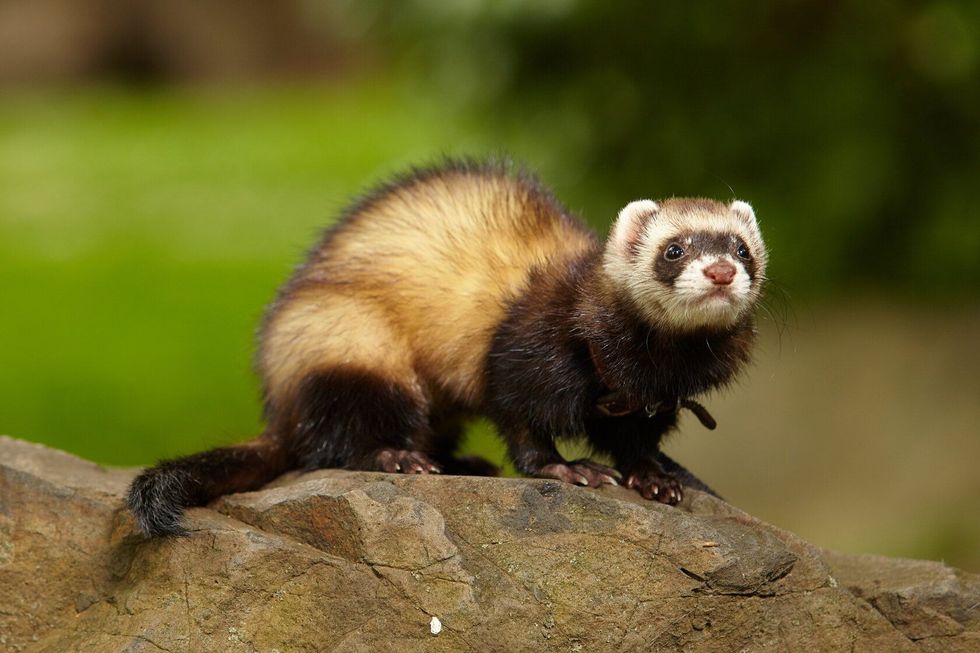Polecats are very attractive with thick, silky, and dark brown fur with a pale yellow underbody.
The European polecat (Mustela putorius) is also known as a forest or black polecat. It is a species of the Mustelidae family native to northwestern Africa and Eurasia.
The European polecat originated during the middle Pleistocene period in western Europe; its close relatives are the black-footed ferret, the steppe polecat, and the European mink. The black-footed ferret has black feet (obviously) with black-tipped tails and long claws.
Polecats have small white ears and white-tipped noses. These mammals have blackish-brown coats in summer, and they have a thicker coat in winter. The average weight of a polecat is 1.5-3.3 lb (0.7-1.5 kg). The male polecat is 1.5 times heavier than females. Males usually eat larger prey, leaving smaller prey for females.
The Mustelidae family has several species, such as the weasel, the stoat, the pine marten, the badger, and the otter. Other species include the honey badger, the American mink, the wolverine, and the fisher.
The polecat is most noticeable in winter when its underfur is longer and thicker. It has a dark facial mask with white fur above the eyes and around the mouth.
European polecats were tamed more than 2,000 years ago. The European polecat is not social like a ferret and likes to be alone at all times, making it less attractive to humans.
They are generally bred for hunting rabbits. The polecat is found in all of the territories in France except in Corsica. Although their numbers are decreasing, it is a Least Concern animal.
Polecats are more dangerous to certain other animals than humans. Polecats are known to mark their territory with an anal spray.
A polecat cools down faster than American minks do. In water with a temperature of 46.6° F (8° C), American minks take 118 minutes to cool, where a polecat takes only 26-28 minutes as their fur is not well insulated against cold water.
To read more European polecat facts and mussels vs. clams, please visit our website.
What is a European polecat's lifespan in captivity?
European polecats are found across Europe on farmland and in forests and have habitats along banks of streams or under tree roots.
Their lifespan can be up to 14 years when in captivity. Let's have a look at polecats, their habitat range, and their conservation status.
When we talk about polecats' conservation status, it is classified as Least Concern. As birds are a key part of their diet, they are thought of as a threat to farmers' chickens.
A polecat's habitat may change depending on food and availability, but polecats have cryptic behavior on average, similar to other mustelids. Polecats are seasonal breeding mammals. The season for mating is between March and May.
One male polecat mating with many female polecats is common. Females give birth to 5-10 young ones, called kits, in a litter.
Kits are covered in silky white fur when they are one week old. When they are three to four weeks old, this fur gets replenished with a cinnamon brown wooly coat. Young kits become independent in two to three months.
What is a European polecat lifespan in the wild?
No European polecat is dangerous until or unless one happens to be its prey.
These wild animals have isolated behavior and are rarely aggressive. If we try to provoke these animals continuously, they may get distressed and bite to protect themselves.
The Mustelid's diet consists of birds followed by rodents and amphibians. Amphibians such as toads became essential food items in winter and spring, decreasing these animals' populations.
European polecats have long fur. They have mask markings on their face and ears. Mustelids have long tails and short legs. Their teeth are huge and strong. The European polecat life span is five years in the wild.
Can you have a polecat as a pet?

As we know, polecats or Mustela putorius are solitary animals. They are also less social than a ferret.
If you have a polecat at home, the house must be thoroughly proofed as polecats climb on furniture and house roofs. However, polecats won't make any mess.
The polecat is a carnivore. Polecats love swimming and they hunt frogs, eels, water voles, and small birds and insects. They hunt for their prey using their sense of smell.
The polecat is an animal that would always want to be alone, but you can have them as pets in your home if you wish.
What is the difference between a European polecat and a ferret?
Polecats and ferrets are about the same size. Female polecats have an average length of 16 in (40.6 cm ) and a tail of 6.3 in (16 cm), where males measure up to 17 in (43 cm) in length.
A domesticated polecat can replace a domestic ferret.
A polecat can be easily identified from the unpleasant smell. A domestic ferret has a curved body with small ears, where a polecat has a long and lean body. The range of both animals' fur length is from medium to long. Another big difference is that ferrets are friendly.
Here at Kidadl, we have carefully created lots of interesting family-friendly facts for everyone to enjoy! If you liked our suggestions for 'European polecat life span: Amazing animal facts that kids will love!' then take a look at where do flies go at night or where do ducks sleep.









